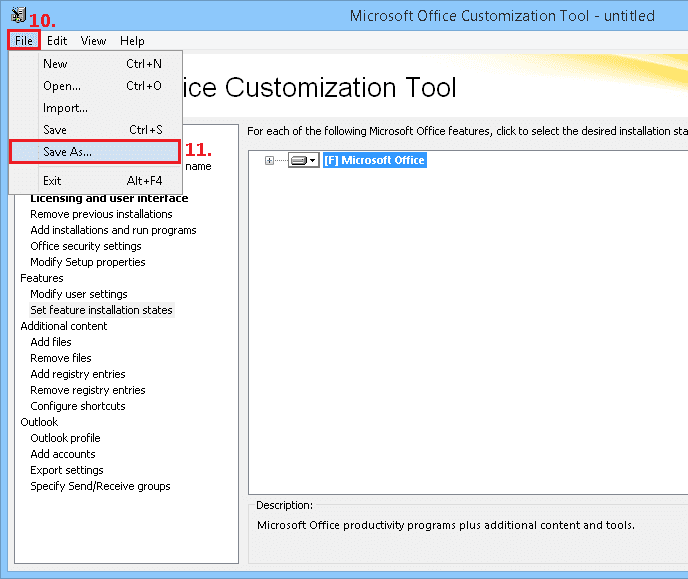

The managed software delivery window will be populated with your package. Resource and go to: Actions > Managed Software Delivery. msp /config ' And to uninstall this product by using the /config switch: 'setup.exe /uninstall STANDARD /config SilentUninstallconfig. We could have also used Command line: setup.exe /config proplus.ww\config.xml /adminfile updates\CustomOffice.msp which will give same results as setup.exe as we have only 1 xml and 1 msp file present in default location, hence both command lines are equivalent in this case. The easiest way to do this is to navigate to Manage > Software > select Software Releases.
#SETUP EXE ADMINFILE PLUS#
See Ref:6Ī) Click on the plus sign > Standard Rule > MSI Product Codeī) Enter the MSI product name for the IdentifyingNumber of the WMI in step 4Ĭ) Uncheck Detect per-user installation for the interactive userħ. Add a detection rule for a Compliance check. Click on the Rules Tab and create a detection rule.
#SETUP EXE ADMINFILE CODE#
Use the IdentifyingNumber for an MSI code of the main products ( in this case it's MS Office Professional Plus 2010)Ħ. Run: WMIC product where "Name like '%office%'" get Name, IdentifingNumber, PackageName, Vendor To gather the msi codes for the software it must be already installed on a machine. Make sure the following are set: See Ref:4Ī) Check if the command line requires a package and Package is using the Office resourceī) Installation type is set to Windows Batch Installation FileĬ) Check the Set as the default for this command type optionĭ) In the Command line enter: CMD.EXE /C “\myfile.bat” (replace myfile.bat with the appropriate filename)ĥ. Select the P ackage tab at the top, select the command line to be used and click on the pencil button to edit the command line. Once uploaded the package resource should open up ( if not, from software releases click on the Office release, right click on the resource and select Actions > Edit Software Resource). Click on the bat file and click on ‘Set Installation File’ See Ref:2ģ. Make sure to import the entire directory by selecting the directory not just the files ( Note: make sure the bat file is in the root directory ).

Import the package into the Symantec Management Platform. If you put the customization file somewhere other than the Updates folder, you can use the Setup command-line option /adminfile to specify the fully qualified path to the file for example, setup.exe /adminfile \\servername\sharename\subfolder\custom.msp. The only difference between the bat file between 20 is the /config switch.įor 2010 use \setup.exe /adminfile mymspfilelocation.mspįor 2013 use \setup.exe /adminfile mymspfilelocation.msp /Config myxmlfile.xmlĢ. adding and removing features through the setup.exe file, using silent install. Make sure to add the software root directory of the software to the command line ( in this case it is 2010std ) See Ref:1 Customizing the Installation with Setup.exe. In this example, Office12 is the root of the network installation.


 0 kommentar(er)
0 kommentar(er)
